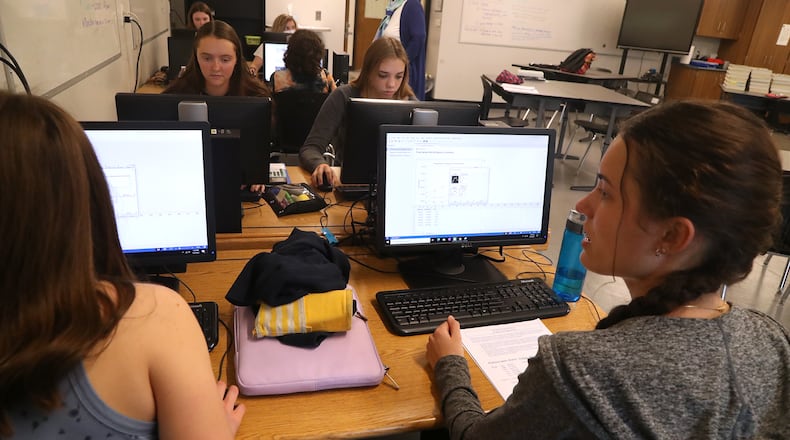All three colleges have seen increasing numbers of high school students graduate with associate degrees in the last five years of the program. It offers college credit courses that can be taken online or on campus.
The trend is continuing across the state: the enrollment in College Credit Plus grew from 54,053 students in the 2015-2016 school year to 76,601 students in 2020-2021, according to the Ohio Department of Higher Education.
According to ODHE, the state pays college course tuition, instructional tools, fees and supplies for public high school students attending public colleges to participate in College Credit Plus.
Clark State College has seen a dramatic increase: just nine high school students graduated from Clark State in the 2017-2018 school year, but 52 high schoolers will graduate this year with an associate degree.
The number of high school students graduating has also increased each year at Clark State since 2017, with 17 in 2018-19; 36 in 2019-20; and 30 in 2020-21.
The college collaborates with more than 50 high school partners and offers college level courses at 31 of them, said Dawayne Kirkman, vice president of student affairs. He said depending on the high school’s CCP course offerings, students have the ability to get the majority of their degree courses at their high school while supplementing with courses at the college or online.
“CCP students who complete a degree or certificate could be minimizing their time either to a Bachelor’s degree or employment, which is also saving students thousands of dollars in tuition, books and fees that they would’ve had to pay if they hadn’t gotten a degree,” Kirkman said. “Completing an associate’s degree can possibly open up additional scholarship opportunities at four year institutions as well.”
Clark-Shawnee High School senior Audrey DeSantis takes CCP classes because they help her towards obtaining her bachelor’s degree. She is majoring in exercise science, and has been able to receive credits for biology, statistics, English, history and pre-calculus.
“I took CCP classes because I will be running (cross country) in college, and getting these classes out of the way will give me credits when I get to (The Ohio State University),” DeSantis said. “Going into college with credits will allow me to focus on courses within my major and allow for flexibility in scheduling, which is helpful as a student-athlete.”
Sinclair Community College has increased the number of high school students in their version of the program each year since 2015-2016, when 12 students were awarded an associate degree by the end of high school. This year, 69 such students were awarded associate degrees, Sinclair said, and more than 8,100 students were enrolled in the College Credit Plus program for the 2021-22 school year.
Sinclair Community College spokeswoman Cathy Petersen said the college will continue to increase enrollment in the program.
Edison State’s numbers have yo-yo’d more than at Sinclair and Clark State. In the 2017-18 school year, 41 high school students graduated with associate degrees. That number dropped to 37 in 2018-19, then dropped again to 31 students in 2019-20. It shot back up to 55 students in 2020-21, but only 25 high schoolers earned degrees this school year.
For high school students, the chance to earn college credit can give them a leg up in getting into the workforce after college, or get them further along the path to a bachelor’s degree at a four-year institution, without the debt.
“When a high school student graduates with an associate degree prior to leaving high school, they have earned a credential at no cost to them,” said Naomi Louis, dean for the school of Arts and Sciences at Clark State. “This more easily allows for the pursuit of their dreams at a four-year institution or a two-year institution that offers bachelor’s degrees like Clark State.”
By the numbers
Statewide enrollment in College Credit Plus
2015-2016: 54,053 students
2016-2017: 68,365
2017-2018: 71,485
2018-2019: 73,152
2019-2020: 76,973
2020-2021: 76,601*
*The Ohio Department of Higher Education attributed this slight decline to COVID-19 and the slight decrease in the number of secondary students in Ohio.
Source: Ohio Department of Higher Education


